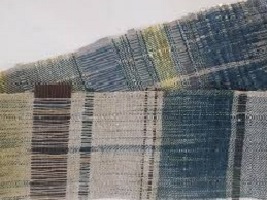
Innovative Textiles: Weaving Solar Fabrics
Forward thinking companies have been designing and developing smart textiles and clothing in holistic ways to change the current fashion system, while ensuring ethical and sustainable practices. Considering the fact that the sun makes life and the elements on our planet possible, in the pursuit of green energy generated from natural resources like the sun, wind or water, the sun becomes part of a system that is essential for the well-being and future of us all. To that end, expanding development into more practical ideas using this inexhaustible energy is key.
In the Netherlands, the company of designer Pauline van Dongen has been developing “zonnestof”, a new textile that has flexible thin-film solar cells woven into it. This material was developed from the idea that a solar textile, unlike the large, rigid solar panels on roofs and solar farms, could offer a more tactile way to interact with and benefit from the sun’s energy. Also, the flexibility and pliability of this textile promises a variety of applications, including textile architecture, tents, canopies and curtains. Such innovative materials provide new ways to use the sun in everyday products, further fostering developments as humans naturally interact with the environment.
As a result, the Pauline van Dongen organization has collaborated with artist and weaving expert Maaike Gottschal of Textielfabrique to explore ideas through hand weaving and using innovative manufacturing processes to promote social and cultural exchange, focusing on how the sun shapes daily practices and rituals.
According to information provided on the Pauline van Dongen website, “Most solar technologies tend to be quite remote from humans, who do not physically interact with the panels on roofs and in the fields. The solar textile ‘zonnestof’ is a form of ‘Solar Design’: by combining the solar cells with yarns and by playing with different weaving patterns and techniques, new aesthetic qualities and material properties are created. The material can be made in a variety of colors, textures, transparencies and thicknesses and is more flexible and pliable compared to large sheets of thin-film solar cells.”
What are some concrete examples of Pauline van Dongen’s wearable technology? Her studio has designed a backpack that incorporates miniature solar power beads with enough energy to charge a smart device while hiking. Another creation is an undershirt that corrects the wearer’s posture, by vibrating when it detects slouching or drooping shoulders, indicating the person should change how they are sitting or standing. And another shirt addresses personal safety by containing washable LED lighting and foil materials that make the presence of runners or walkers more visible at night.
By creating zonnestof workshops with another Dutch business called Bureau Ruimtekoers, the company invites people to “weave a new future together” by participating in further development to explore how the role of solar energy can manifest itself in daily life. According to the Pauline van Dongen website, “participants become owners of the project through their contribution and thus become part of a larger movement.”



This is very exciting!
Imagine a future where canvas awnings and shading structures could combine solar collection with integrated fiber optics or micro LED to provide shade in the daytime and an illuminated sheet at night. This would avoid solar gain during the day and eliminate the need for supplemental lighting at night.
The possibilities are endless.